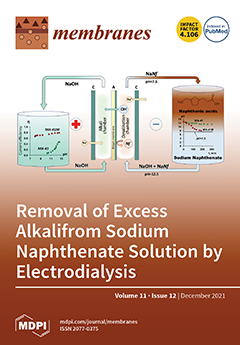Torlon
® is a thermally and plasticization-resistant polyamide imide characterized by low gas permeability at room temperature. In this work, we aimed at improving the polymer performance in the thermally-enhanced He/CO
2 and H
2/CO
2 separations, by compounding Torlon
® with
[...] Read more.
Torlon
® is a thermally and plasticization-resistant polyamide imide characterized by low gas permeability at room temperature. In this work, we aimed at improving the polymer performance in the thermally-enhanced He/CO
2 and H
2/CO
2 separations, by compounding Torlon
® with a highly permeable filler, ZIF-8, to fabricate Mixed Matrix Membranes (MMMs). The effect of filler loading, gas size, and temperature on the MMMs permeability, diffusivity, and selectivity was investigated. The He permeability increased by a factor of 3, while the He/CO
2 selectivity decreased by a factor of 2, when adding 25 wt % of ZIF-8 at 65 °C to Torlon
®; similar trends were observed for the case of H
2. The MMMs permeability and size-selectivity were both enhanced by temperature. The behavior of MMMs is intermediate between the pure polymer and pure filler ones, and can be described with models for composites, indicating that such materials have a good polymer/filler adhesion and their performance could be tailored by acting on the formulation. The behavior observed is in line with previous investigations on MMMs based on glassy polymers and ZIF-8, in similar conditions, and indicates that ZIF-8 can be used as a polymer additive when the permeability is a controlling aspect, with a proper choice of loading and operative temperature.
Full article






